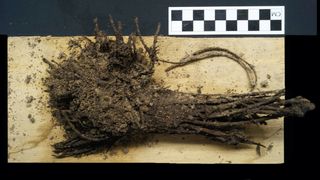Aug. 25 (UPI) -- The "smell of fear" emitted by predator insects may help farmers and gardeners seeking to protect what they grow from plant-eating bugs resistant to traditional pesticides, research presented Wednesday during the American Chemical Society meeting found.
Herbivorous insects present a major threat to plants and crops but the predator insects that feed on these bugs emit odors that pests can sense, the researchers said.
Smelling this odor causes pests to change their behavior and, in some cases, their physiology -- body structure -- to avoid being eaten, they said.
However, the researchers, from the Pennsylvania State University, have developed a way to bottle this smell to repel and disrupt destructive insects naturally, without the need for harsh chemicals that may also harm other, beneficial insects.
"Insects rely on olfactory cues to find food, mates and places to live," one of the researchers, Jessica Kansman, said in a press release.
"This is a great opportunity to investigate how to use these smells to manipulate their behavior," said Kansman, a post-doctoral researcher at Penn State in State College.
Insects called aphids are a highly destructive pest to an array of crops, and their large numbers, ability to transmit plant pathogens and increased resistance to insecticides make them a persistent problem for growers, according to the researcher
These insects also happen to be a favorite food of the ladybug, which gardeners welcome as a source of sustainable pest management, the researchers said.
Earlier research by the same team found that aphids and other herbivorous insects avoid fields and gardens if they can smell predators nearby.
In addition, exposure to the odor cues given off by ladybugs can cause aphids to slow their rates of reproduction and increase their ability to grow wings, both of which are behaviors designed to avoid threats, according to the researchers.
To see whether the olfactory cues given off by ladybugs could, by themselves, control pests, the researchers identified and extracted the volatile odor profile from live ladybugs using gas chromatography-mass spectrometry.
This process allowed them to identify and separate the individual components of the ladybugs' smell, the researchers said.
To see which compounds the herbivorous insects would respond to, the researchers hooked up the antennae of live bugs to an electroantennogram machine and exposed them to each individual odor the ladybug emitted to see which compounds were detected.
The strength of their reactions was measured based on the signal picked up by the machine, according to the researchers.
Of the many compounds emitted by ladybugs, herbivorous insects had the strongest response to chemicals called methoxypyrazines, including isopropyl methoxypyrazine, isobutyl methoxypyrazine and sec-butyl methoxypyrazine.
The researchers then used the chemicals produced by the ladybugs to create a special odor blend that can be used in an essential oil diffuser for spreading across a garden or field.
Next, the team plans to conduct field tests of their scent diffusers to see if the effects on herbivorous insects and ladybugs are similar to what was observed in the lab.
They also want to determine the dispersal area of the diffusers, and whether they could be applied to other pests and predators, as well as various types of crops, the researchers said.
In addition, they are collaborating with a manufacturing company to design special diffusers for eventual commercial use by both farmers and gardeners, they said.
"It is not uncommon to use our senses to avoid risky situations -- if a building was on fire, we as humans could use our senses of sight or smell to detect the threat," researcher Sara Hermann said in a press release.
"There is evidence for such behavioral responses to risk across taxa that suggest prey organisms can detect predation threats, but the mechanisms for detection aren't very well understood, especially with insects," she said.
ATLANTA, Aug. 25, 2021 — For home gardeners and farmers, herbivorous insects present a major threat to their hard work and crop yields. The predator insects that feed on these bugs emit odors that pests can sense, which changes the pests’ behavior and even their physiology to avoid being eaten. With bugs becoming more resistant to traditional pesticides, researchers now report they have developed a way to bottle the “smell of fear” produced by predators to repel and disrupt destructive insects naturally without the need for harsh substances.
The researchers will present their results today at the fall meeting of the American Chemical Society (ACS). ACS Fall 2021 is a hybrid meeting being held virtually and in-person Aug. 22-26, and on-demand content will be available Aug. 30-Sept. 30. The meeting features more than 7,000 presentations on a wide range of science topics.
“It is not uncommon to use our senses to avoid risky situations. If a building was on fire, we as humans could use our senses of sight or smell to detect the threat,” says Sara Hermann, Ph.D., the project’s principal investigator. “There is evidence for such behavioral responses to risk across taxa that suggest prey organisms can detect predation threats, but the mechanisms for detection aren’t very well understood, especially with insects.”
“Insects rely on olfactory cues to find food, mates and places to live, so this is a great opportunity to investigate how to use these smells to manipulate their behavior,” says Jessica Kansman, Ph.D., a postdoc who is presenting the work at the meeting. Hermann and Kansman are at the Pennsylvania State University.
Aphids are a highly destructive pest to an array of crops, and their large numbers, ability to transmit plant pathogens and increased resistance to insecticides make them a persistent problem for growers. They also happen to be a favorite food of the ladybug, which gardeners welcome as a source of sustainable pest management. Hermann’s research has shown that aphids and other herbivorous insects will steer clear of fields and gardens if they can smell predators nearby. Not only that, but exposure to the odor cues given off by ladybugs can also cause aphids to slow their reproduction rates and increase their ability to grow wings, both of which are behaviors designed to avoid threats.
With these observations in mind, the research team set out to determine whether the olfactory cues given off by ladybugs could, by themselves, control pests. They started by identifying and extracting the volatile odor profile from live ladybugs using gas chromatography – mass spectrometry, which separates and allows for identification of the individual components of the ladybugs’ smell. To see which compounds the aphids would respond to, they hooked up the antennae of live aphids to an electroantennogram (EAG) machine and exposed them to each individual odor the predator emitted to see which compounds they detected. The strength of their reactions was measured based on the signal picked up by the EAG machine. Of the many compounds emitted by ladybugs, aphids had the strongest response to methoxypyrazines, such as isopropyl methoxypyrazine, isobutyl methoxypyrazine and sec-butyl methoxypyrazine. Once the compounds were identified, Hermann and team set out to create a special odor blend that can be used in an essential oil diffuser that will spread the scent over time across a garden or field.
Next, the team plans to conduct field tests of their scent diffusers to see if the effects on aphids and ladybugs are similar to what they observed in the lab. Hermann and Kansman also want to determine the dispersal area of the diffusers, and whether they could be applied to other pests and predators, as well as various types of crops. In addition, they are collaborating with a manufacturing company to design special diffusers for eventual commercial use by both farmers and gardeners.
A recorded media briefing on this topic will be posted Wednesday, Aug. 25 at 9 a.m. Eastern time at www.acs.org/acsfall2021briefings.
###
The researchers acknowledge support and funding from the U.S. Department of Agriculture National Institute of Food and Agriculture.
The American Chemical Society (ACS) is a nonprofit organization chartered by the U.S. Congress. ACS’ mission is to advance the broader chemistry enterprise and its practitioners for the benefit of Earth and all its people. The Society is a global leader in promoting excellence in science education and providing access to chemistry-related information and research through its multiple research solutions, peer-reviewed journals, scientific conferences, eBooks and weekly news periodical Chemical & Engineering News. ACS journals are among the most cited, most trusted and most read within the scientific literature; however, ACS itself does not conduct chemical research. As a leader in scientific information solutions, its CAS division partners with global innovators to accelerate breakthroughs by curating, connecting and analyzing the world’s scientific knowledge. ACS’ main offices are in Washington, D.C., and Columbus, Ohio.
To automatically receive press releases from the American Chemical Society, contact newsroom@acs.org.
Note to journalists: Please report that this research was presented at a meeting of the American Chemical Society.
Follow us: Twitter | Facebook | LinkedIn | Instagram
Title
Smell of fear: Harnessing predatory insect odor cues as a pest management tool for herbivorous insects
Abstract
Predatory insects are highly valued tools in the sustainable management of herbivorous insects in agroecosystems. Considerable research focuses on recruiting and retaining natural enemies that consume and thus reduce herbivore populations that damage crop plants. However, the mere risk of predation can provoke changes in herbivore behavior and physiology that can influence herbivore reproductive capacity and survival. The contribution of these fitness affecting risk-responses (known as non-consumptive effects) in suppressing herbivorous pest populations as a pest management tool is far less explored, as well as identification of the mechanisms used by the herbivore to detect predation risk. The goal of our study was to ask 1) do the odor cues from predators play a role in risk detection by prey and 2) are these odor cues capable of eliciting non-consumptive effects in prey organisms? We ask these questions using the herbivorous green peach aphid (Myzus persicae (Sulzer)), the predatory multi-colored Asian lady beetle (Harmonia axyridis (Pallas)), and collards (Brassica oleracea) as a system. In this study, we first identified the volatile odor profile of H. axyridis using GC-MS, and assessed the bioactivity of the compounds and blend using GC-EAG. We further explored the impact of these odor cues on M. persicae using two-choice olfactometer assays. We also found that exposure to H. axyridis volatile odor cues affects M. persicae host-plant choices and reproductive capacity in laboratory experiments. This approach was critical in determining if prey odor cues lead to changes in herbivore behavior and performance that ultimately benefit plant productivity. Harnessing non-consumptive effects through the use of natural enemy odor cues is a promising future direction for applied chemical ecology in sustainable pest management.
























